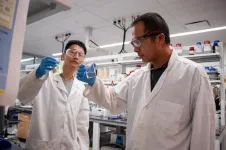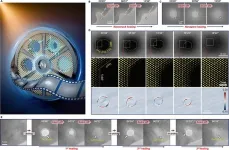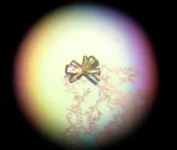(Press-News.org) A team led by scientists at the Department of Energy’s Oak Ridge National Laboratory identified and successfully demonstrated a new method to process a plant-based material called nanocellulose that reduced energy needs by a whopping 21%. The approach was discovered using molecular simulations run on the lab’s supercomputers, followed by pilot testing and analysis.
The method, leveraging a solvent of sodium hydroxide and urea in water, can significantly lower the production cost of nanocellulosic fiber — a strong, lightweight biomaterial ideal as a composite for 3D-printing structures such as sustainable housing and vehicle assemblies. The findings support the development of a circular bioeconomy in which renewable, biodegradable materials replace petroleum-based resources, decarbonizing the economy and reducing waste.
Colleagues at ORNL, the University of Tennessee, Knoxville, and the University of Maine’s Process Development Center collaborated on the project that targets a more efficient method of producing a highly desirable material. Nanocellulose is a form of the natural polymer cellulose found in plant cell walls that is up to eight times stronger than steel.
The scientists pursued more efficient fibrillation: the process of separating cellulose into nanofibrils, traditionally an energy-intensive, high-pressure mechanical procedure occurring in an aqueous pulp suspension. The researchers tested eight candidate solvents to determine which would function as a better pretreatment for cellulose. They used computer models that mimic the behavior of atoms and molecules in the solvents and cellulose as they move and interact. The approach simulated about 0.6 million atoms, giving scientists an understanding of the complex process without the need for initial, time-consuming physical work in the lab.
The simulations developed by researchers with the UT-ORNL Center for Molecular Biophysics, or CMB, and the Chemical Sciences Division at ORNL were run on the Frontier exascale computing system — the world’s fastest supercomputer for open science. Frontier is part of the Oak Ridge Leadership Computing Facility, a DOE Office of Science user facility at ORNL.
“These simulations, looking at every single atom and the forces between them, provide detailed insight into not just whether a process works, but exactly why it works,” said project lead Jeremy Smith, director of the CMB and a UT-ORNL Governor’s Chair.
Once the best candidate was identified, the scientists followed up with pilot-scale experiments that confirmed the solvent pretreatment resulted in an energy savings of 21% compared to using water alone, as described in the Proceedings of the National Academy of Sciences.
With the winning solvent, researchers estimated electricity savings potential of about 777 kilowatt hours per metric ton of cellulose nanofibrils, or CNF, which is roughly the equivalent to the amount needed to power a house for a month. Testing of the resulting fibers at the Center for Nanophase Materials Science, a DOE Office of Science user facility at ORNL, and U-Maine found similar mechanical strength and other desirable characteristics compared with conventionally produced CNF.
“We targeted the separation and drying process since it is the most energy-intense stage in creating nanocellulosic fiber,” said Monojoy Goswami of ORNL’s Carbon and Composites group. “Using these molecular dynamics simulations and our high-performance computing at Frontier, we were able to accomplish quickly what might have taken us years in trial-and-error experiments.”
The right mix of materials, manufacturing
“When we combine our computational, materials science and manufacturing expertise and nanoscience tools at ORNL with the knowledge of forestry products at the University of Maine, we can take some of the guessing game out of science and develop more targeted solutions for experimentation,” said Soydan Ozcan, lead for the Sustainable Manufacturing Technologies group at ORNL.
The project is supported by both the DOE Office of Energy Efficiency and Renewable Energy’s Advanced Materials and Manufacturing Technologies Office, or AMMTO, and by the partnership of ORNL and U-Maine known as the Hub & Spoke Sustainable Materials & Manufacturing Alliance for Renewable Technologies Program, or SM2ART.
The SM2ART program focuses on developing an infrastructure-scale factory of the future, where sustainable, carbon-storing biomaterials are used to build everything from houses, ships and automobiles to clean energy infrastructure such as wind turbine components, Ozcan said.
“Creating strong, affordable, carbon-neutral materials for 3D printers gives us an edge to solve issues like the housing shortage,” Smith said.
It typically takes about six months to build a house using conventional methods. But with the right mix of materials and additive manufacturing, producing and assembling sustainable, modular housing components could take just a day or two, the scientists added.
The team continues to pursue additional pathways for more cost-effective nanocellulose production, including new drying processes. Follow-on research is expected to use simulations to also predict the best combination of nanocellulose and other polymers to create fiber-reinforced composites for advanced manufacturing systems such as the ones being developed and refined at DOE’s Manufacturing Demonstration Facility, or MDF, at ORNL. The MDF, supported by AMMTO, is a nationwide consortium of collaborators working with ORNL to innovate, inspire and catalyze the transformation of U.S. manufacturing.
Other scientists on the solvents project include Shih-Hsien Liu, Shalini Rukmani, Mohan Mood, Yan Yu and Derya Vural with the UT-ORNL Center for Molecular Biophysics; Katie Copenhaver, Meghan Lamm, Kai Li and Jihua Chen of ORNL; Donna Johnson of the University of Maine, Micholas Smith of the University of Tennessee, Loukas Petridis, currently at Schrödinger and Samarthya Bhagia, currently at PlantSwitch.
UT-Battelle manages ORNL for DOE’s Office of Science, the single largest supporter of basic research in the physical sciences in the United States. The Office of Science is working to address some of the most pressing challenges of our time. For more information, please visit energy.gov/science.
END
Molecular simulations, supercomputing lead to energy-saving biomaterials breakthrough
2024-09-06
ELSE PRESS RELEASES FROM THIS DATE:
Low-impact yoga and exercise found to help older women manage urinary incontinence
2024-09-06
Older women struggling with urinary incontinence can benefit from regular, low-impact exercise, with yoga as well as stretching and strengthening showing benefits in a new study published Aug. 27 in Annals of Internal Medicine.
The research, led by scientists at Stanford Medicine and the University of California, San Francisco, is part of a larger effort to identify low-risk, low-cost ways to treat one of the most common health problems women face as they age.
After 12 weeks of a low-impact yoga program, study participants had about 65% fewer episodes of incontinence. Women in a control group doing stretching and strengthening exercises ...
Genetic studies reveal new insights into cognitive impairment in schizophrenia
2024-09-06
In a comprehensive review of recent genetic and population studies, published in the peer-reviewed medical journal Genomic Psychiatry (Genomic Press, New York), Professors Michael Owen and Michael O'Donovan of Cardiff University's Centre for Neuropsychiatric Genetics and Genomics present evidence that challenges conventional wisdom about cognitive deficits in schizophrenia. Their analysis reveals that premorbid cognitive impairment – lower IQ and other cognitive deficits present before the onset of psychosis – is largely explained by non-familial factors rather than by the same inherited genetic variants that ...
Researcher develops technology to provide cleaner energy and cleaner water
2024-09-06
As the world transitions to cleaner energy sources, the need for energy-relevant metals and critical minerals has surged dramatically. Driven by the rise of electric vehicles and other green technologies, these essential materials are in high demand across the globe.
Metals, such as lithium, cannot be grown. They must be mined or recycled, making this a top priority for researchers in the mining industry. Traditional methods of mining lithium are expensive and can be harmful to the environment, but researchers at Virginia Tech have found a way to minimize this environment impact. They will optimize and scale up this method with ...
Expect the unexpected: nanoscale silver unveils intrinsic self-healing abilities
2024-09-06
As an innovative concept in materials science and engineering, the inspiration of self-healing materials comes from living organisms that have the innate ability to self-heal. Along with this line, the search for self-healing materials has been generally focused on “soft” materials like polymers and hydrogels. For solid-state metals instead, one may intuitively imagine that any form of self-healing will be much more difficult to achieve.
While a few past studies showcased the self-healing behavior in metals that more or less requires the assistance ...
nTIDE September 2024 Jobs Report: Gains in employment for people with disabilities appear to level off after reducing gaps with non-disabled workers
2024-09-06
East Hanover, NJ – September 6, 2024 – Employment and labor force participation trends for people with disabilities appear to be stabilizing after several years of growth that reduced the gaps between individuals with and without disabilities, according to today’s National Trends in Disability Employment – semi-monthly update (nTIDE) issued by Kessler Foundation and the University of New Hampshire’s Institute on Disability (UNH-IOD).
Over the past three months, both groups have seen declines in employment and labor force participation, reflecting a broader workforce ...
Wiley enhances NMR Spectral Library Collection with extensive new databases
2024-09-06
Wiley, one of the world’s largest publishers and a global leader in research and learning, today announced the addition of ten computed CNMR databases totaling over 384,000 records to its KnowItAll NMR Spectral Library collection. With this addition, the KnowItAll NMR collection now provides access to over 1.3 million spectra, making it one of the most comprehensive collections of NMR spectral data available.
“These new databases significantly enhance our ability to support researchers in their quest ...
Renowned psychiatrist Dr. Gustavo Turecki sheds light on depression, suicide, and brain trauma response
2024-09-06
Montreal, Canada - The "Innovators & Ideas: Research Leader" section of Genomic Psychiatry (ISSN: 2997-2388), published by Genomic Press, New York, features an illuminating Genomic Press Interview with Dr. Gustavo Turecki, a trailblazer in psychiatric research at McGill University. The interview delves into Turecki's pioneering work on depression, suicide prevention, and the molecular underpinnings of mental health, offering valuable insights into cutting-edge research shaping our understanding of these critical issues.
Dr. Turecki, who serves as the Chair of the Department of Psychiatry at McGill ...
Plasmonic modulators could enable high-capacity space communication
2024-09-06
Researchers have achieved data rates as high as 424Gbit/s across a 53-km turbulent free-space optical link using plasmonic modulators— devices that uses special light waves called surface plasmon polaritons to control and change optical signals. The new research lays the groundwork for high-speed optical communication links that transmit data over open air or space.
Free-space-optical communication networks could aid space exploration because they can provide high-speed, high-capacity data transmission with lower latency and less interference than traditional radio frequency communication systems. ...
UPenn’s Orphan Disease Center to amplify SYNGAP1 research: SynGAP Research Fund’s Million Dollar Bike Ride team raises $74,851 for one-year grant
2024-09-06
Mill Valley, CA – September 5, 2024 – The SynGAP Research Fund 501(c)(3) is proud to announce its continued collaboration with the University of Pennsylvania’s (UPenn) Orphan Disease Center (ODC) through the Million Dollar Bike Ride (MDBR) Pilot Grant Program. ODC is accepting proposals for a grant award of $74,851 to further advance critical research in SYNGAP1-Related Disorders (SRD). Instructions for submitting a letter of interest are available here. Applications are due in two weeks by September 20, 2024.
Why We Participate in This Project
The SynGAP Research ...
Crystallized alternative DNA structure sheds light on insulin and diabetes
2024-09-06
The first crystal structure of an alternative DNA shape from the insulin gene has been revealed by a UCL-led research team.
DNA is widely accepted to be formed of two strands that wind around one another, known as a double helix, but it is possible for DNA to change shape and structure. The new study, published in Nature Communications, reveals the detail in the structure of a type of DNA called i-motif by crystallising it for the first time.
Co-lead author Dr Zoë Waller (UCL School of Pharmacy) ...






